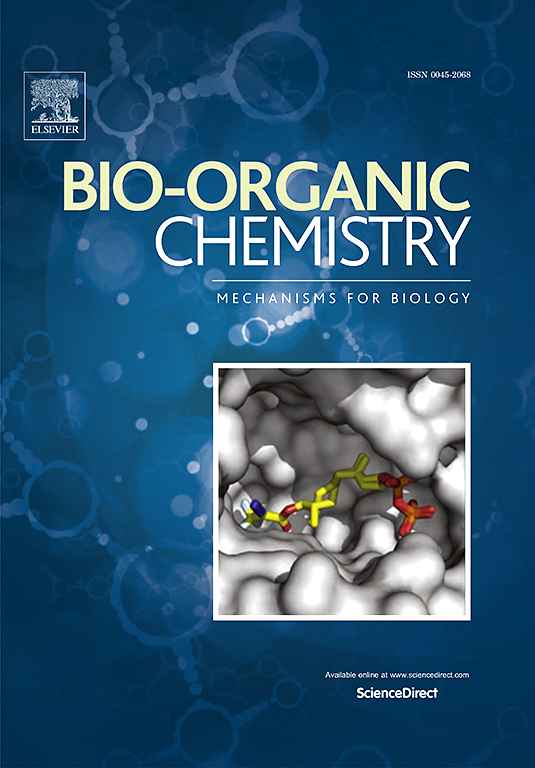Substituted aryl piperazine ligands as new dual 5-hLOX/COX-2 inhibitors. Synthesis, biological and computational studies
IF 4.5
2区 医学
Q1 BIOCHEMISTRY & MOLECULAR BIOLOGY
引用次数: 0
Abstract
Two series of cyano (1a-l) and amino (2a-l) aryl piperazines were synthesized and evaluated for their inhibitory activity against 5-lipoxygenase (5-hLOX) and cyclooxygenase-2 (COX-2). The newly designed derivatives feature diphenyl methyl (a-d), phenyl (e-h), or methoxyphenyl (i-l) groups, respectively, and demonstrated significant inhibition of 5-hLOX. Noteworthy were compounds 1b, 1 g, 1 k, 2f, and 2 g, exhibiting IC50 values ranging from 2.2 to 3.3 μM. The most potent inhibitors (1b, 1 g, 1 k, 2c, and 2f) were characterized by a competitive inhibition mechanism, with Ki values ranging between 1.77 μM and 9.50 μM. Additionally, compounds 2a, 2b, 2 g, and 2 h displayed promising dual inhibition of 5-hLOX and COX-2, with IC50 values below 15 μM. Cytotoxicity assessments against HEK293 cells revealed that the cyano derivatives (1a-l) were non-cytotoxic (CC50 > 200 μM), whereas the amino derivatives (2a-l) exhibited moderate cytotoxicity (CC50 < 50 μM). Notably, the most active derivatives against both targets were non-cytotoxic at their respective inhibitory concentrations. Computational studies, including docking and molecular dynamics simulations, indicated that compound 1 g demonstrated greater stability within the catalytic site of 5-hLOX compared to compound 2f, correlating with the higher affinity observed in kinetic assays. Furthermore, quantitative structure-activity relationship (QSAR) analyses revealed strong correlations between theoretical and experimental IC50 values (97 % for 1a-l and 93 % for 2a-l). These findings, combined with absorption, distribution, metabolism, and excretion (ADME) predictions, suggest that these derivatives are promising candidates as dual inhibitors of 5-hLOX and COX-2.

求助全文
约1分钟内获得全文
求助全文
来源期刊

Bioorganic Chemistry
生物-生化与分子生物学
CiteScore
9.70
自引率
3.90%
发文量
679
审稿时长
31 days
期刊介绍:
Bioorganic Chemistry publishes research that addresses biological questions at the molecular level, using organic chemistry and principles of physical organic chemistry. The scope of the journal covers a range of topics at the organic chemistry-biology interface, including: enzyme catalysis, biotransformation and enzyme inhibition; nucleic acids chemistry; medicinal chemistry; natural product chemistry, natural product synthesis and natural product biosynthesis; antimicrobial agents; lipid and peptide chemistry; biophysical chemistry; biological probes; bio-orthogonal chemistry and biomimetic chemistry.
For manuscripts dealing with synthetic bioactive compounds, the Journal requires that the molecular target of the compounds described must be known, and must be demonstrated experimentally in the manuscript. For studies involving natural products, if the molecular target is unknown, some data beyond simple cell-based toxicity studies to provide insight into the mechanism of action is required. Studies supported by molecular docking are welcome, but must be supported by experimental data. The Journal does not consider manuscripts that are purely theoretical or computational in nature.
The Journal publishes regular articles, short communications and reviews. Reviews are normally invited by Editors or Editorial Board members. Authors of unsolicited reviews should first contact an Editor or Editorial Board member to determine whether the proposed article is within the scope of the Journal.
 求助内容:
求助内容: 应助结果提醒方式:
应助结果提醒方式:


